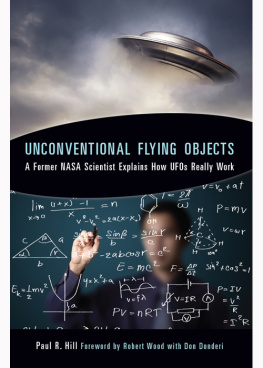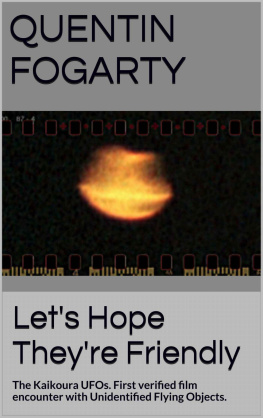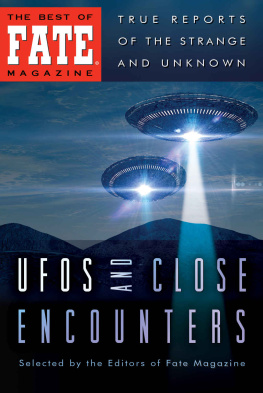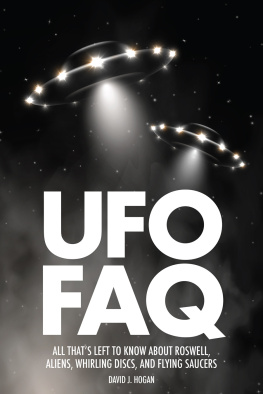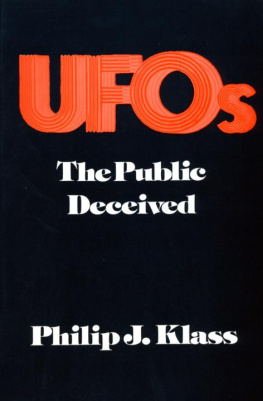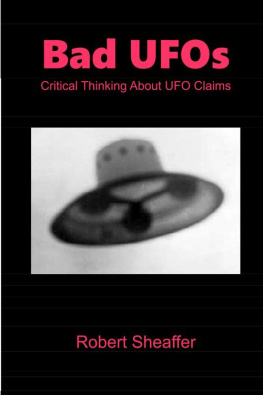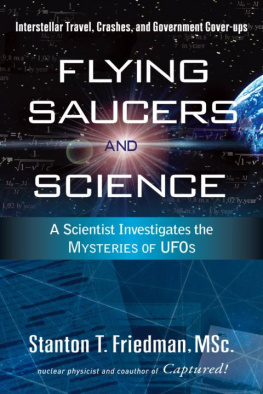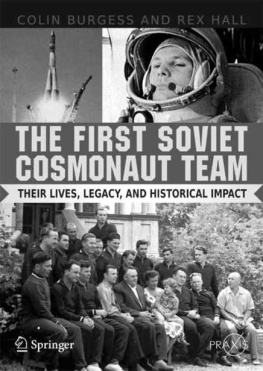Paul R. Hill - Unconventional Flying Objects: A Former NASA Scientist Explains How UFOs Really Work
Here you can read online Paul R. Hill - Unconventional Flying Objects: A Former NASA Scientist Explains How UFOs Really Work full text of the book (entire story) in english for free. Download pdf and epub, get meaning, cover and reviews about this ebook. year: 2014, publisher: Hampton Roads, genre: Art. Description of the work, (preface) as well as reviews are available. Best literature library LitArk.com created for fans of good reading and offers a wide selection of genres:
Romance novel
Science fiction
Adventure
Detective
Science
History
Home and family
Prose
Art
Politics
Computer
Non-fiction
Religion
Business
Children
Humor
Choose a favorite category and find really read worthwhile books. Enjoy immersion in the world of imagination, feel the emotions of the characters or learn something new for yourself, make an fascinating discovery.
- Book:Unconventional Flying Objects: A Former NASA Scientist Explains How UFOs Really Work
- Author:
- Publisher:Hampton Roads
- Genre:
- Year:2014
- Rating:5 / 5
- Favourites:Add to favourites
- Your mark:
- 100
- 1
- 2
- 3
- 4
- 5
Unconventional Flying Objects: A Former NASA Scientist Explains How UFOs Really Work: summary, description and annotation
We offer to read an annotation, description, summary or preface (depends on what the author of the book "Unconventional Flying Objects: A Former NASA Scientist Explains How UFOs Really Work" wrote himself). If you haven't found the necessary information about the book — write in the comments, we will try to find it.
Paul R. Hill: author's other books
Who wrote Unconventional Flying Objects: A Former NASA Scientist Explains How UFOs Really Work? Find out the surname, the name of the author of the book and a list of all author's works by series.
Unconventional Flying Objects: A Former NASA Scientist Explains How UFOs Really Work — read online for free the complete book (whole text) full work
Below is the text of the book, divided by pages. System saving the place of the last page read, allows you to conveniently read the book "Unconventional Flying Objects: A Former NASA Scientist Explains How UFOs Really Work" online for free, without having to search again every time where you left off. Put a bookmark, and you can go to the page where you finished reading at any time.
Font size:
Interval:
Bookmark:
UNCONVENTIONAL FLYING OBJECTS
a scientific analysis
Paul Hill has done a masterful job ferreting out the basic science and technology behind the elusive UFO characteristics and demonstrating they are just advanced and exotic extensions of our own technologies. Perhaps this book will help bring solid consideration for making all that is known about extraterrestrial craft publicly available.
Edgar Mitchell, Sc.D.,
Apollo 14 Astronaut

Copyright 1995 by Julie M. Hill
Foreword 2014 by Robert M. Wood and Don C. Donderi
All rights reserved. No part of this publication may be reproduced or transmitted in any form or by any means, electronic or mechanical, including photocopying, recording, or by any information storage and retrieval system, without permission in writing from Hampton Roads Publishing, Inc.
Reviewers may quote brief passages.
Cover design by Jim Warner
Cover art: space ship shutterstock / Fer Gregory
Figure shutterstock / Dusit
Hampton Roads Publishing Company, Inc.
Charlottesville, VA 22906
Distributed by Red Wheel/Weiser, llc
www.redwheelweiser.com
Sign up for our newsletter and special offers by going to www.redwheelweiser.com/newsletter/.
ISBN: 978-1-57174-713-6
Printed in the United States of America.
EBM
10 9 8 7 6 5 4 3 2 1
www.redwheelweiser.com
www.redwheelweiser.com/newsletter
NASA aeronautical engineer Paul R. Hill began to collect and analyze evidence about unidentified flying objects (UFOs) during the 1950s, but he could not publish anything about UFOs while employed by NASA. After Hill died in 1991, it was possible to publish the book that he wrote while working for NASA, Unconventional Flying Objects. Hill was a good engineerhe designed the fuselage for the World War II P-47 fighter-bomberand his UFO analysis drew on his knowledge of the physics and engineering of flight. While at NASA, Hill designed and flew a machine that used the same basic principle of thrust that he used to explain UFO propulsionexcept, as he had to admit, the anti-gravity drive. That drive would have allowed that principle to explain the observed near-earth performance of UFOs, and by extension, their interstellar performance. Hill knew that UFO technology so far exceeded the capability of terrestrial technology that UFOs could not have been made by humans: therefore, they have come here from somewhere else in the universe.
Hill's approach was 20 years ahead of its time. He never became trapped in the endless speculation about the reality of UFOs; he accepted the reports at face value and let his analysis of the observed phenomenon speak for itself. And his methodology was impeccable. He took the reported observations and then directly evaluated alternative hypotheses, exploring all relevant aspects of the observations. His comprehensive analyses dealt with size, color, halos, clouds, wakes, jitter, heat, maneuvers, performance, sound, solidity, landing, weight, nests and rings, propulsion, propulsive forces, force fields, radiation, merging systems, occupants, collecting, interference, weaponry and artifacts.
Although written in technically precise language, Unconventional Flying Objects is easy to understand because Hill sticks to the central principles of flight, dynamics and electricity, and he uses those clearly explained principles to clarify the remarkable set of reports he compiled. The plain narrative style and the clear observations bring the book within the reach of the non-technical reader. The case histories are easy to follow, and the information unfolds like a mystery story unraveling its plot. Sketches are simple and focus on the point in question, as if Hill were drawing them on the blackboard in his office for the visiting reader. Interspersed within the observational narrative are quantitative explanations for much of what Hill observed. The calculations are simple, comprehensible and checkable thro ugh-outone of the necessary conditions for good technical work. The appendices carry the quantitative analysis further than in the narrative chapters, and they will interest the engineer and scientist.
As Paul Hill knew, as our scientific predecessors of the seventeenth, eighteenth and nineteenth centuries knew, and as we know, science begins with systematic observation. Observation is the foundation on which experiment, and eventually theory, is built. Observational UFO evidence began to accumulate during World War II, was still accumulating when Hill wrote Unconventional Flying Objects, and continues to accumulate as we write. There are close-range, multiple-witness reports by trained observers, visual observations coincident with radar tracking, ground traces of visually observed UFOs, and dogfights between UFOs and the fighter jets of various nations, recorded on radar and reported by the pilots themselves. We have each independently reviewed more than sixty-five years of UFO evidence. On the basis of this evidence, we both know, as did Hill, that some UFOs must be extraterrestrial vehicles.
Given the continually accumulating, and by now very public, body of evidence for extraterrestrial UFOs, why do so many leaders in science, culture and government still deny their reality? Extraterrestrial contact is upsetting for all of us. To admit that technologically superior extraterrestrials are in contact with us is scientifically embarrassing because we do not understand nature as well as the extraterrestrials, it leaves us culturally uncertain what to do about it, and it makes governments anxious about what might happen as a result. The embarrassments, uncertainties and anxieties weigh heavily on the meritocracies of science, culture and government. People resist embarrassing, uncertainty-provoking and anxiety-producing facts by building psychological defenses that allow them to maintain a state of denial that is less upsetting than the facts.
In 1890 William James explained how facts that are unrelated to any of our mental frames of reference are just not recognizedor if recognized, are only fleetingly acknowledgedbecause we have no mental category with which to associate them. We do not now have the science to explain UFO performance, so the technical frame of reference for UFO evidence is lacking, and this makes the evidence easy to ignore. In 1909, Sigmund Freud theorized that upsetting facts may be repressed out of conscious awareness, at the psychological cost of a subsequent neurosis. If your professional focus is national defense, repression may be the only way you can quiet your anxiety about our technological unpreparedness to deal with an extraterrestrial adversary. In 1975, Leon Festinger explained that unpleasant facts can be ignored by metaphorically shooting the messenger: when you denigrate and diminish the messenger's importance or credibility, you discredit the facts. If your role is political, shooting the UFO messenger is easier than briefing your constituents on the reality of extraterrestrial UFOs. All of these psychological defense mechanisms have been used to ignore, dismiss or deny the accumulated evidence about the existence of extraterrestrial UFOs.
The philosopher Arthur Schopenhauer wrote: All truth passes through three stages. First, it is ridiculed. Second, it is violently opposed. Third, it is accepted as being self-evident. Hill's book has helped to move the evidence for extraterrestrial UFOs far beyond ridicule and has helped to position it in the public mind somewhere between violently opposed and accepted as self-evident. Reading Unconventional Flying Objects
Next pageFont size:
Interval:
Bookmark:
Similar books «Unconventional Flying Objects: A Former NASA Scientist Explains How UFOs Really Work»
Look at similar books to Unconventional Flying Objects: A Former NASA Scientist Explains How UFOs Really Work. We have selected literature similar in name and meaning in the hope of providing readers with more options to find new, interesting, not yet read works.
Discussion, reviews of the book Unconventional Flying Objects: A Former NASA Scientist Explains How UFOs Really Work and just readers' own opinions. Leave your comments, write what you think about the work, its meaning or the main characters. Specify what exactly you liked and what you didn't like, and why you think so.

